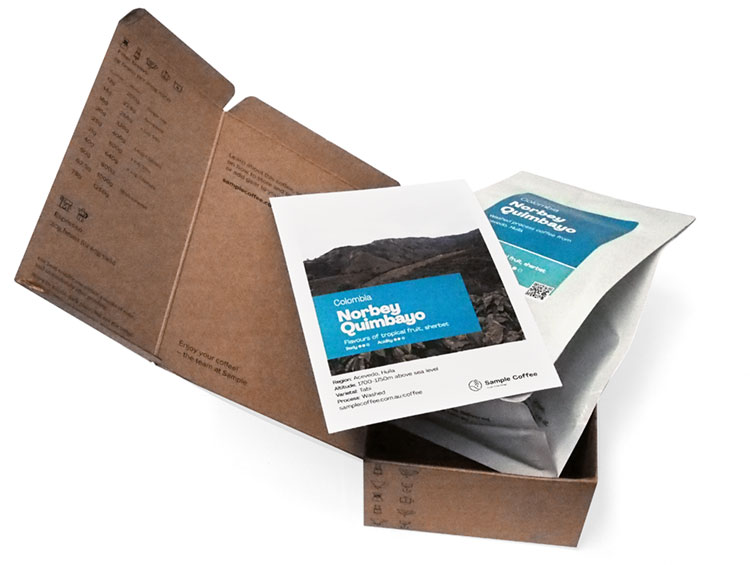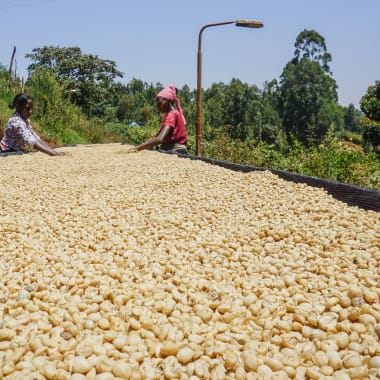-
Producer
-
Salume Ramadahn
-
Country
- Burundi
-
Region
-
Kayanza
-
Altitude
-
1800 – 1900m above sea level
-
Varieties
-
Process
-
Harvested
-
April 2014
-
Importer
-
Nordic Approach
-
Body
-
Medium
-
Acidity
-
Medium
-
Tasting notes
-
Candied orange, stone fruit
-
Roast style
Burundi
Shembati
This week’s coffee is a mix from three microlot farms in the southern Huila region of Colombia. Rosalba Burgos and Pedro Claros are both farmers in the town of Pitalito, and Deifilia Diaz’s farm is just over the hill in the town Acevedo.
As small lots of coffee from farms so close together, all of a similar quality, they were combined at the warehouse in Pitalito to add complexity and balance to the coffee. The combined lot is also more practical for export.
We were impressed by how great this coffee tastes, so we’re sharing it with you even though it’s not our usual single-farm approach.
What’s with the AAA?
The coffee industry often uses extra letters after the name of a coffee to indicate extra details about the beans. Not along ago we shared the Gakuyuni PB with subscribers, where the PB indicated a pea berry (there’s more detail on what pea berry means on that coffee page).
What letters are added and what they signify often varies depending on the country.
Virmax, our importing partner in Colombia, grades each coffee when it’s delivered by farmers in each town. To be considered for export through Virmax, the coffee needs to score at least 83.
A coffee which scores 83 or 84 is given an A grade, those scoring 85-86 are AA, and anything 87 and above is given a AAA grade score, the highest possible quality.
The price paid to the farmer increases to reflect the grade.
There’s a great interview with Virmax about their processes in Colombia and how they work with farmers to improve quality at the Square Mile Roasters blog.
Learn everything about this coffee:
Ethical, traceable sourcing
This page has all the sourcing information (variety, process, region, story, importer, and more) that our importers share with us, and give us permission to use.
The transparency helps us talk confidently about the quality and background of our product, and it helps you know exactly what you’re buying.
Learn more:
Coffee page transparency legend
Our coffee philosophy
Our business approach
Fresh harvest coffee
We only source and roast coffee from each country’s latest harvest season (so the green coffee is never older than 1 year from the time of picking, processing and packing). This ensures the sensory qualities are always at their peak and unaffected by excessive ageing.
Roasted for espresso and filter (best enjoyed black)
Roast style: omni. Omni roasts are designed to brew and taste great both as espresso and filter. Our omni single origins generally sit on Agtron values in the ~70-60 value range. So, technically, they are somewhere in the lighter side of the medium spectrum.
Designed for espresso and filter brewing. Best enjoyed black.
Learn more:
Our Loring Kestrel S35 roaster
Our roasting style and approach
Best brewed within days 15-49 post-roast
The ‘fresh is best’ saying doesn’t apply to coffee (contrary to popular belief). Waiting before opening and brewing your bag of whole coffee beans helps develop peak flavour and acidity.
But heads up: if you buy pre-ground coffee, brew it as soon as possible.
Learn more:
Our recommended brewing window
Try our custom brewing recipes
Our recipes and ratios are tailored to our coffee sourcing and roasting styles, bringing the best flavour and feel out of each coffee.
For pour over, immersion, and other filter brewing styles, check our brew guides.
For our espresso single origins, we recommend a coffee:yield ratio of 1:3:
- Dose: 20g ground coffee
- Yield: 60g espresso
- Total brew time: ~24-28 seconds
This is just a starting point! We encourage you to experiment, taste, and adjust to find the recipe that you enjoy the most.
Learn more:
Our espresso brew guide (single origin)
Brewing ratio calculator
Packaging and sustainability
- Bags: ABA-certified home compostable (AS 5810-2010)
- Labels: recyclable
- Valves (only on +250g bags): general waste
- Box and tape (online orders): recyclable
Learn more:
Our packaging
Varieties
Bourbon variety
A natural mutation of the Typica varietal, Bourbon is named after Reunion Island (then known as Il Bourbon) where the French cultivated the Typica plants which naturally mutated.
Ethiopian Heirloom variety
Heirloom (or sometimes Landrace) is an umbrella term that refers to all the coffee varietals endemic to Ethiopia.
The location
Coffee from Burundi
Coffee first arrived in Burundi in the 1920s while the country was still under Belgian colonial rule. Since the civil war in 1993 Burundi has placed a great importance on growing the coffee industry and the flow on effects that will have on the country’s economy.
The Kayanza region of Burundi
Northern region near the Rwandan border
Farm processes
Washed process
Machines are used to remove the flesh from the coffee cherry before being fermented in water, washed again, and finally sun dried. This process tends to result in more distinct, cleaner flavours.
3 brew notes from subscribers
Burundi Shembati
Toby’s V60
- 14g
- 250ml
- 2m 30s
Burundi Shembati
Dylan’s V60
Smooth. Somewhat neutral... slightly sweet. Not bitter. Tasty.
- 18g
- 300ml
- 2m 10s
Burundi Shembati
Tim’s Aeropress
- 18g
- 75s

Subscribe to a world of coffee
Discover a new single origin coffee from Sample every 1-5 weeks with no delivery fees.
No up-front purchase, and you can pause, cancel, or change plans at any time.
Available to order online this week:

Kenya Karindundu Aa
Flavours of orange marmalade, grapefruit, Yunnan red tea
Body Acidity
Washed Batian, SL28, SL34, Ruiru 11
Roasted omni for filter and espresso
Kenya Karindundu Aa online
Ethiopia Bekele Gemeda
Flavours of mandarin, white peach, mango
Body Acidity
Washed Ethiopian Heirloom
November 2024 harvest
Roasted omni for filter and espresso
Ethiopia Bekele Gemeda online
Nicaragua Guillermo Montenegro
Flavours of plum, nectarine, shortbread
Body Acidity
Washed Caturra
March 2025 harvest
Roasted omni for filter and espresso
Nicaragua Guillermo Montenegro online
Colombia Carlos Imbachi Pink Bourbon
Flavours of pear, jasmine, sugarcane
Body Acidity
Washed Pink Bourbon
February 2025 harvest
Roasted omni for filter and espresso
Colombia Carlos Imbachi Pink Bourbon online